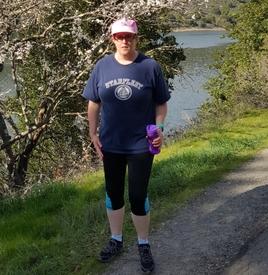Creating the habit of food weighing

TaraTall
Posts: 339 Member
Okay. I now feel comfortable enough to say that I've created the habit of logging most meals and even just checking in to MFP for about a month consecutive now.
Next step is to have more accurate measurements of my food. I have a food scale at my disposal, so that's a plus. However, I find it challenging to create this habit.
Any pro tips or suggestions on how I can do it?
Next step is to have more accurate measurements of my food. I have a food scale at my disposal, so that's a plus. However, I find it challenging to create this habit.
Any pro tips or suggestions on how I can do it?
0
Replies
-
I keep my kitchen scale on my counter where I prepare my food. Having it in plain sight can be a helpful reminder.0
-
I usually will log whatever food I plan to eat in a minute, then I actually weigh it, then I change the log to reflect the accurate weight (as opposed to the guess I just entered) then I eat it. The going back and fixing the wrong thing is my motivation. I'm a stickler for accuracy and I can't even look at the entry while it's incorrect without the burning desire to fix it. My food scale lives on my counter. I don't think it's ever seen the inside of a cabinet.0
-
That sounds helpful.
I was also thinking of zero-ing out my scale with my lunch tupperware on it, then magic markering the added weights for each thing that goes into it? (ie - broccoli, chicken, rice)
Another note, I have read that it's best to weigh your meat raw. How do you manage to do this if you're bulk meal prepping? I get all my chicken breasts mixed up like a mom with triplets!0 -
I've found you only have to do it a few times and you start to know what 4 ounces of chicken looks like and what a cup of veggies looks like. This is helpful for eating out, I immediately cut my portions down to appropriate sizes and then pack up the rest as leftovers. I use the scale for double checking myself occasionally, especially if I hit a plateau, sometimes it helps push me through.0
-
That sounds helpful.
I was also thinking of zero-ing out my scale with my lunch tupperware on it, then magic markering the added weights for each thing that goes into it? (ie - broccoli, chicken, rice)
Another note, I have read that it's best to weigh your meat raw. How do you manage to do this if you're bulk meal prepping? I get all my chicken breasts mixed up like a mom with triplets!
Weighing it cooked shouldn't be an issue. Just make sure that the entry that you use reflects that. That's where people tend to get in trouble.0 -
My suggestion is make note about what keeps you from using it and work on removing those obstacles. I know a lot of people like leaving it out to remind themselves, but for me the opposite is true. I made space in a drawer for my scale and enjoy taking it out every time I'm prepping a meal. It feels like a ritual of taking care of myself.
Two problems I used to have were that my old scale was always shutting off quickly because it was trying to conserve its battery (fine, but it was a pain) and also I like to be able to use any plate in my kitchen on the scale and sometimes if you use a large bowl or plate you can't see the numbers on the scale so I researched and found a scale that fixed both those problems. It was well worth the money given how much more I enjoy using my new Oxo scale, which has a pull-out readout. (Although after I'd ordered it someone on the forums suggested you could just put a small bowl on the scale and then put your plate on top of that to raise the plate and allow you to see the numbers regardless of which plate you use so that's a good fix, too!)
I hardly even think about it now and it has become habit. Something that helped in the beginning to make it a habit was that I would tell myself I was weighing to make sure I was getting my full portion of something. If you eyeball something you could just possibly be cheating yourself. ( I know that's not normally the case, but it helped motivate my use of the scale!)
0 -
-
All good ideas so far. I will add using the tare feature helps a lot. Took me sadly longer then I care to admit to use it.0
-
Mine is always on the counter, ready to be used. Its a little Starfrit scale, inexpensive, from Canadain Tire. I too wondered about weighing on big plates but figured out a good technique, which has been mentioned above!0
-
@ncfitbit - I learned something today. I often do what you do, and put a big plate on the scale to weigh things like chicken. But it covers up the numbers, and I have to look all around, shift the plate a bit to see the numbers. Small bowl under plate is absolute genius!!!0
-
So helpful (most) of you!
I think keeping it out with a notepad will be the best way to start. I've at least already created half the process habit now it's just finishing the job.
Thanks!0 -
I have one at home and one at work.0
-
That sounds helpful.
I was also thinking of zero-ing out my scale with my lunch tupperware on it, then magic markering the added weights for each thing that goes into it? (ie - broccoli, chicken, rice)
Another note, I have read that it's best to weigh your meat raw. How do you manage to do this if you're bulk meal prepping? I get all my chicken breasts mixed up like a mom with triplets!
You should weigh your food every time. Use the tare function to subtract the weight of the dish. I weigh my meat cooked and I used a food entry that reflects that the meat has been cooked. The final weight of meat can differ based on the amount of fat and water in it.
A $20 digital scale has a tare function and keeps showing the result after the dish is removed.0 -
Mine's out all the time as I weigh my pets' food too, and I log on my phone as I'm weighing (my food, not the pets!). It really doesn't matter how you do it though, and doesn't have to be complicated.0
-
CurlyCockney wrote: »Mine's out all the time as I weigh my pets' food too, and I log on my phone as I'm weighing (my food, not the pets!). It really doesn't matter how you do it though, and doesn't have to be complicated.
LOL, thanks for the clarification! 0
0 -
I actually log the weight I want first, then put that amount into whatever I'm making. I already know how many grams of tomato, mushroom, meat, veg I prefer. So I prelog it all, then when I go to cook I just cut up that amount and keep using the tare button.0
-
i also got a scale to keep at work, so i can weigh whatever i randomly pick up at target/walmart on my lunch breaks so i cant cheat. groupon always has them on sale it seems0
-
For me, it was seeing more success in weighing.. I went through the usual "Im logging, why am I not losing", of course I was estimating and waaaaay off.. "Serving" meant what 'I' consider is a serving. I had NO IDEA what 6oz of chicken looked like, or 220g of cheerios ( to me 600g was a serving).
Not quite to the point where I am comfortable 'eyeballing' yet, but I can see working again (as mentioned above) once I re-learn portions.0 -
-
I didn't read all of the responses so I apologize if these are repeats but here goes:
Use the tare option often. I will put a bowl on the scale, add lettuce - log, tare, add tomato - log, tare, add avocado - log, etc. I do this until my bowl/plate is full or I have logged my target calories. The key is to log cooked meat if you use this method.
Buy snack size baggies and pre-portion your snacks out. This way, you do all your weighing at one time and don't have to bother when you want something. This works for proteins in the freezer as well. Buy your meat, portion it out into freezer bags. Write the weight on the bag and toss it in the freezer. Then you don't have to weigh on cooking day.
Keep a scale at work. I use it to weigh out items that I add into my yogurt or the frozen fruit (kept in the freezer at my work kitchen) I throw into a ninja (also kept at work) for smoothies. I use the tare in between ingredients and log on my phone as I go.
For items like peanut butter, weigh the spoon, scoop then put it back on the scale. It's the easiest way I have found to do things like nut butters, butter, honey, jam, etc. I used to spread it then weigh but if I used more than I wanted, I couldn't put it back easily like I can if I weigh the amount on my spoon.0 -
I LOVE the pre portioning idea. So simple!0
-
I keep a magnetic mini-dry erase board and magnetic holder dry-erase pen attached to my metal range-hood. It's right next to the counter with my pretty Ozeri scale where I prepare my food. That way I don't waste paper, since I write down weights every day. amazon.com/Quartet-ReWritables-Dry-Erase-Assorted-79201/dp/B003KGBGOA/ref=pd_sim_229_2?ie=UTF8&dpID=41VbZVlYQLL&dpSrc=sims&preST=_AC_UL160_SR160%2C160_&refRID=1E202EPW9RJAPJNNJ71M0
-
Start by just weighing a couple of things you eat consistently. I started with just veggies and fruits at first. Once that became habit I started weighing my cooked food as I prepared my plate. Tare option is a must. It's also cleaner to weigh an entire fruit or vegetable then subtract the peel or tare the cutting board have a waste bowl handy while prepping.0
-
Another tip: if your scale displays negative numbers (most do but not all) you can put a jar or container of something on the scale, tare the scale, and then use some. The negative number will be how much you used. I do this a lot for things like mayo or peanut butter that could get messy to weigh by the spoonful!0
-
LaceyBirds wrote: »I keep a magnetic mini-dry erase board and magnetic holder dry-erase pen attached to my metal range-hood. It's right next to the counter with my pretty Ozeri scale where I prepare my food. That way I don't waste paper, since I write down weights every day.
Same! I keep my tupperware on the scale, [example] toss in all my berries (prewashed) then write it all behind me on the fridge. On my lunch break at work or the night before (depends when I do food prep), I then log it from the picture I take of it on my phone.
I always do my best to weigh meats raw. I usually buy bulk foods then split them out into two-person meal portions (possibly including lunch the next day depending on the size). Then, once hygienically in the plastic bag, I weigh the meat, put the amount on the bag in Sharpie, then toss it in the freezer for when I need it. Now I never have the excuse for not weighing my food. So far it's help a TON.0 -
LaceyBirds wrote: »I keep a magnetic mini-dry erase board and magnetic holder dry-erase pen attached to my metal range-hood. It's right next to the counter with my pretty Ozeri scale where I prepare my food. That way I don't waste paper, since I write down weights every day. amazon.com/Quartet-ReWritables-Dry-Erase-Assorted-79201/dp/B003KGBGOA/ref=pd_sim_229_2?ie=UTF8&dpID=41VbZVlYQLL&dpSrc=sims&preST=_AC_UL160_SR160%2C160_&refRID=1E202EPW9RJAPJNNJ71M
This is brilliant! I've been dragging my notebook into the kitchen when I cook dinner, but the fridge white-board is right there. (I'm a little slow sometimes...)
Just start with a few things, and pretty soon you'll start being curious about everything and start weighing more. And pretty soon it will become an unconscious habit. I caught myself weighing the cat's canned food the other night. (That was bad enough, but then I started laughing at myself and my husband came in to find out what so funny... I'm never living that down. never.)
0 -
diannethegeek wrote: »Another tip: if your scale displays negative numbers (most do but not all) you can put a jar or container of something on the scale, tare the scale, and then use some. The negative number will be how much you used. I do this a lot for things like mayo or peanut butter that could get messy to weigh by the spoonful!
Great idea...I will try this.0 -
If you're making something like a salad, put the bowl on the scale, tare (zero) it, add the first ingredient, note the ingredient & weight; tare again, add the next ingredient, etc.
If you're dipping something out of a container (like peanut butter), or cutting off a hunk of something (like cheese), it may be most convenient to put the storage container (or block of cheese) on the scale, tare, dip out or cut/remove your portion, re-weigh the container or block, and use the negative number on the scale (i.e., the weight of the portion removed, the one you're going to eat) as what you record in your diary (as a positive number, of course ).
).
I also like to keep a few washed plastic yogurt-tub lids handy to sit raw or messy things on when I weigh them, so I don't have to wipe the scale as much - just put the lid on the scale & tare before adding the ingredient.0 -
OOOHHH!!!!If you're making something like a salad, put the bowl on the scale, tare (zero) it, add the first ingredient, note the ingredient & weight; tare again, add the next ingredient, etc.
If you're dipping something out of a container (like peanut butter), or cutting off a hunk of something (like cheese), it may be most convenient to put the storage container (or block of cheese) on the scale, tare, dip out or cut/remove your portion, re-weigh the container or block, and use the negative number on the scale (i.e., the weight of the portion removed, the one you're going to eat) as what you record in your diary (as a positive number, of course ).
).
I also like to keep a few washed plastic yogurt-tub lids handy to sit raw or messy things on when I weigh them, so I don't have to wipe the scale as much - just put the lid on the scale & tare before adding the ingredient.
0
This discussion has been closed.
Categories
- All Categories
- 1.4M Health, Wellness and Goals
- 398.2K Introduce Yourself
- 44.7K Getting Started
- 261K Health and Weight Loss
- 176.4K Food and Nutrition
- 47.7K Recipes
- 233K Fitness and Exercise
- 462 Sleep, Mindfulness and Overall Wellness
- 6.5K Goal: Maintaining Weight
- 8.7K Goal: Gaining Weight and Body Building
- 153.5K Motivation and Support
- 8.4K Challenges
- 1.4K Debate Club
- 96.5K Chit-Chat
- 2.6K Fun and Games
- 4.8K MyFitnessPal Information
- 12 News and Announcements
- 21 MyFitnessPal Academy
- 1.6K Feature Suggestions and Ideas
- 3.2K MyFitnessPal Tech Support Questions























